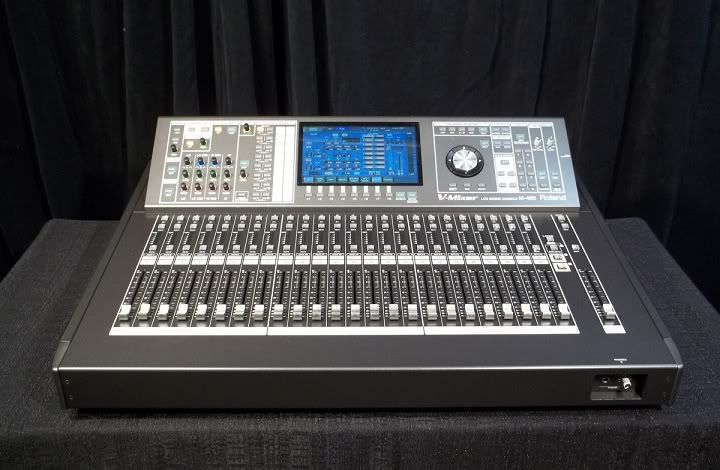
The M-480 digital console is a primary component in the steadily expanding V-Mixing system family from Roland Systems Group that also includes other console models, as well as digital snakes, personal mixers, protocol interfaces and the new R-1000 multi-track digital recorder.
The M-480 is the largest console in the series (other models include the 400, 380 and 300), offering 48 mixing channels plus 6 stereo returns (for a total of 60 channels), left/center/right outputs, 16 aux buses and 8 matrices. Using proprietary REAC (Roland Ethernet Audio Communication) digital protocol, the system is configurable up to 90 inputs and 90 outputs. A compressor and gate is provided on all mixing channels, with 6 stereo multi-effects processors and 12 graphic EQs available for patching.
For this Road Test, Roland also provided two of the three available models of snake boxes, as well as some CAT cabling on reels. (More about these facets later.)
Feature Set
The first thing I noticed is how lightweight and compact the console is, even in the flight case that it shipped with. Itís very easy for one person to manage the console in the case, as well as pick up or move the console by itself. Dimensions are 29.6 x 24.3 x 9.1 inches (w x d x h), and weight is 44 pounds. The desk is well built and seems like it can easily handle the ďrigors of the road.Ē
Setting up the console without a snake connected is easy because the rear panel offers 8 patchable inputs and 8 patchable outputs. There is also a stereo pair of RCA input jacks and an XLR input for talkback microphone. Rounding out the connectors on the rear are an optical and coaxial digital output, USB, MIDI and RS232 jacks, and of course the RJ45 etherCON REAC digital snake ports. A recessed headphone jack and volume control are provided on the front.
Here is a shot of the rear of the M-480

Getting around on the console is very intuitive, and I found that I didnít even crack open the manual until I tried to map layers and assign effects. Speaking of the manual, it was very easy to use. The sections are logically laid out, and the text is clear and concise on how to accomplish routing, patching, and tweaking. (I wish more product manuals were as clear!)
During testing, I plugged in a mic and then went to plug in my computer to playback some tracks while I familiarized myself with the controls. Thatís when I discovered that the M-480 does not include a digital input on the rear. What I thought were SPDIF connectors were actually stereo RCA analog line inputs Ė certainly not a deal breaker for me, but some audio folks want/need a digital input on their console. And, note that digital I/O can be found in the S-4000S snake configuration with AES/EBU I/O.
After an hour or so, I had the hang of the console, and let an audio buddy who had stopped by my shop check it out. He also liked the layout of the control surface, and the large screen made it easy to see what was going on as he made adjustments.
The nice large screen
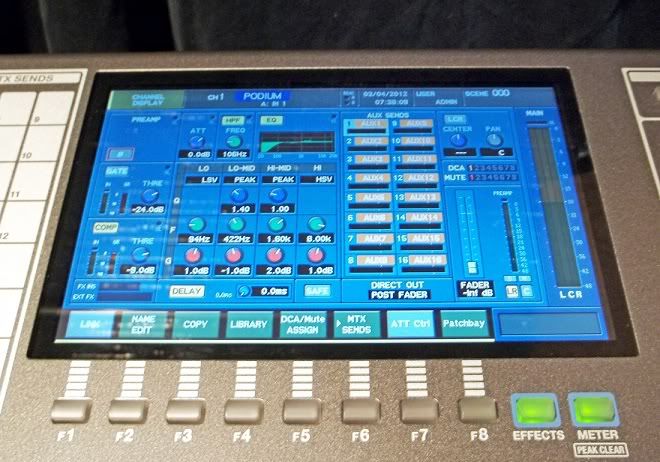
I guess Iím getting spoiled by my iPad, iPhone, and almost every other newer gadget, because I kept thinking the M-480 sported a touchscreen. However, while that would be nice and perhaps a bit faster in terms of making adjustments, the consoleís jog/shuttle wheel and enter buttons were plenty fast for the type of gigs that I usually do. Once I got the hang of the wheel, I had no trouble easily accessing the various parameters and making adjustments quickly.
Here is a pic of the jog shuttle wheel located to the right of the screen
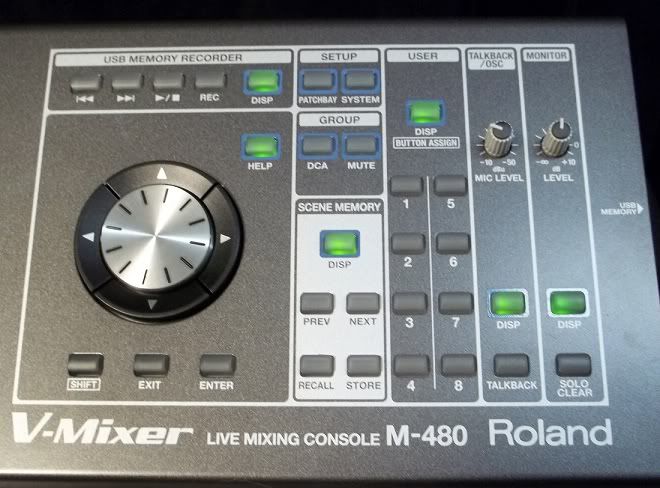
Here is a picture of the channel editing section located to the left of the screen
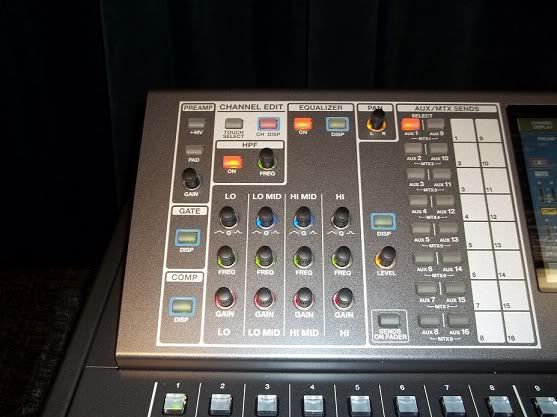
Snakes & Cables
It was time to set up the digital snake systems and see how they all fit together. I started with the smaller S-1608 box, which is well built and can be rack-mounted or used as a stand-alone floor box. A large handle at one end makes it easy to move around.
The S-1608 offers 16 XLR inputs and 8 XLR outputs. Each input comes with an amber LED showing phantom power status, a green LED for signal, and a red LED for clip. A master power LED and REAC LED let you know the status of the box at a glance. Controls include a REAC mode switch to configure the system, and a ďmute all inputsĒ switch that I thought was a handy feature until it was accidentally pressed when plugging in a cable at a gig. I had forgotten the button was there, and spent a few minutes trying to figure out why I could not get signal from the box to the console.
Next up was the larger S-4000S rack-mountable digital snake head, which arrived in the typical configuration of 32 XLR inputs and 8 XLR outputs. It offers remote controllable mic preamps and redundant Ethernet ports as well as the same features as the S-1608. Itís 6RU and weights 37.8 pounds, and itís modular package lets you configure the system exactly the way you need it.
The S-1608 and the larger S-4000S digital snake boxes
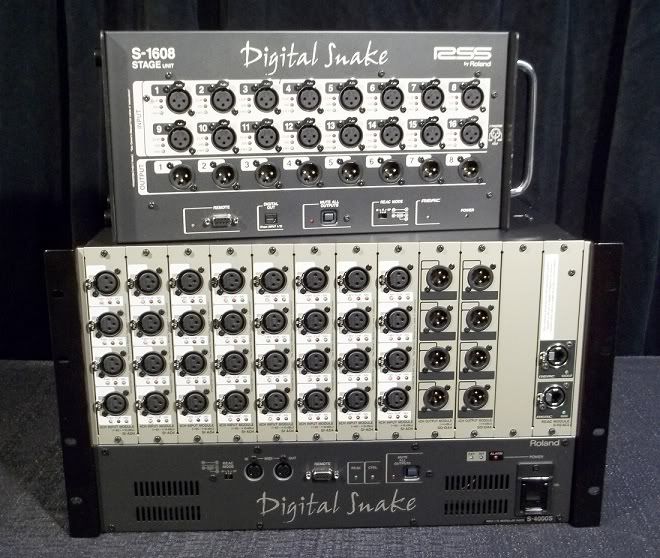
Roland also provided a W100S-R reel with 100 meters (328 feet) of Cat-5e cable outfitted with etherCON connectors. Iím a big fan of cable reels and have a bunch of various sized reel systems in my inventory, so I donít say lightly that the W100S-R is a very good reel, and the cable is rugged yet flexible.
W100s reel
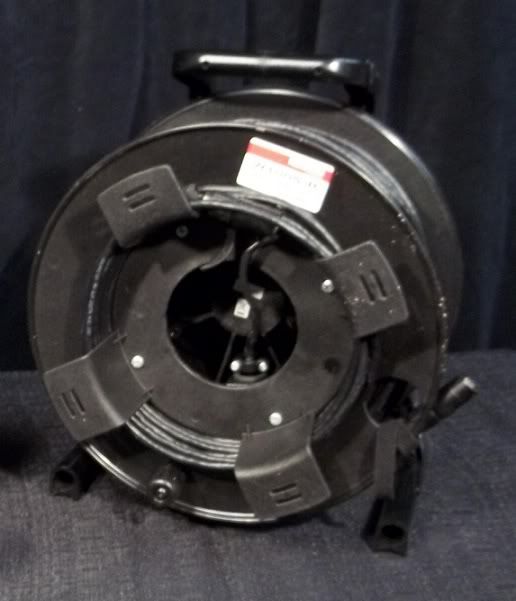
Note that the third available stage box, the S-0816, wasnít supplied for this evaluation. Itís essentially a handy ďfront of houseĒ box that could be used with the S-1608 to make a simple 16 input x 8 output point to point snake system.
In The Field
The first gig I deployed the package was a small meeting with a few podium mics and some wireless systems, as well as music playback from my laptop. I plugged the laptop into the stereo RCA jacks on the console and used the console inputs for the wireless units.
The S-1608 was positioned near the stage, used it to run the podium mics back to the console and the consoleís main outputs to my amplifier rack for the loudspeakers. Running the Cat-5 snake was way easier and quicker as compared to my analog audio snakes, and Steve, the A2 at the event, had never even seen the console before but within minutes had all of the basics figured out without looking at the manual.
The next gig was a larger corporate event that included a lot of video and computer playback. During a run through I noticed that the audio track in one feed from video world was not in sync with the video portion shown on the screens. I carry a small digital delay I can patch in just for situations like these, but with a digital delay on every input and output in the console, it was easy to add the required amount of delay and line up the words with the lips on screen.
A week later I did a luncheon award banquet in a ballroom that Iím all too familiar with. The best place for front of house is usually in the rear right corner of the room whereís thereís power and a house audio tie-in panel available, as well as house lighting controls.
Unfortunately, this requires a 250-foot snake run through the back service hallway, with lots of ladder work running the cable up and over the many doorways between the kitchen areas and the ballroom. Normally it takes two people about an hour to run an analog snake, but in running Cat-5 from the reel, I did the job myself in less than 20 minutes.
Final Analysis
The final show included a 5-piece dance band performing after a corporate presentation. The load-in schedule was tight, and when the band showed up late, we were really crunched for time. The pre-set libraries of the M-480 provided a great starting place for getting a sound quickly. Then it was just a matter of tweaking the sound to taste, instead of starting from scratch for every channel. The effects units sound great, and it was simple to adjust any parameter.
Mixing on the M-480 is easy. Unlike some consoles that require you to go through menu after menu to get to certain parameters, on the M-480 the most often used features are available directly via dedicated buttons and knobs on the surface itself. Then if you need to adjust a parameter, itís usually only one click to bring up that screen and all of the controls are clearly displayed.
The M-480 also offers some features I didnít really get a chance to explore including 2-track recording direct to a drive via USB, remote access and offline editing, and the ability to cascade two consoles together to make a much larger desk.
Overall, Iím impressed with the console as well as the entire V-Mixing system. It offers tons of features in a compact package, and at a good price point. MSRP for the system tested: M-480 is $11,795; S-4000S is $6,495; S-1608 is $2,095. Also note that a new version of the M-480, available as a free update, was announced at the recent Prolight + Sound show last month.

